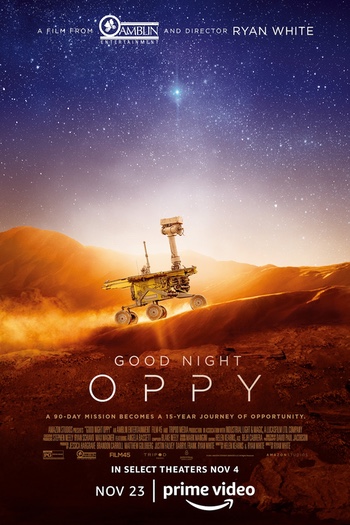Review: Good Night Oppyby Jeff Foust
|
| The film examines how robots like Spirit and Opportunity are treated as people by those who built and used them. |
The impending demise of InSight stirs up memories of two other spacecraft, the twin Mars Exploration Rovers Spirit and Opportunity, which far outlived their 90-day missions. Spirit lasted until 2011 and Opportunity until 2018, when a powerful dust storm deprived the solar-powered rover of sunlight. Both rovers were celebrated, and mourned, as if they were colleagues of the engineers who built them and the scientists who used them to search for signs the planet could once have been habitable. The lives and deaths of those rovers are recounted in the new documentary Good Night Oppy, which debuted in theaters last Friday and will be available on the Amazon Prime streaming service November 23.
At one level, Good Night Oppy is a basic documentary about the twin Mars rovers. Using archival footage along with interviews, the film largely follows a chronological approach, starting with principal investigator Steve Squyres’ long-running efforts to send rovers to Mars, though the rovers’ development, launch, and landing, and then their extended operations. The story of those operations, including the technical problems and scientific breakthroughs, are also told through brief “mission log” entries voiced by actress Angela Bassett, the closest the film comes to any narration.
On a deeper level, though, the film examines how robots like Spirit and Opportunity are treated as people by those who built and used them. The anthropomorphizing of the rovers was widely publicized during the missions, but it was more than just an outreach gimmick. Those who helped create them describe in the movie how the identical rovers had distinct “personalities” in their development: one recalled that while Spirit often ran into problems during those tests, Opportunity was “Little Miss Perfect.” That extends back even to the design of the rovers, which put the cameras at the height of an average person and with similar visual acuity, as if it was a person standing on the surface viewing the terrain.
That continued during their extended missions. When Opportunity starting having problems moving a shoulder joint in its robotic arm, it was described as being “arthritic.” One person who joined the team later in the mission drew comparisons between the memory problems Opportunity’s rover started having late in its mission with her grandmother’s Alzheimer’s diagnosis.
| It's not surprising, then, that when the rovers each the end of their missions they are mourned. For those who have worked on the rovers for years, they have become a part of their lives as deeply as a friend or family member. |
The filmmakers augment the interviews and archival footage with computer-generated animations of the rovers on the Martian surface, offering stunning depictions of the rovers’ travels. The film, perhaps, pushes those depictions a little too far: at the times the rovers are beeping, clicking, and whirring, sounding like Martian cousins of R2-D2 as they respond to commands from Earth. (And, no, sadly, it’s unlikely either rover cruised across the Martian landscape while playing The B-52’s “Roam”.)
It's not surprising, then, that when the rovers each the end of their missions they are mourned, even though they are robots that far exceeded expectations. For those who have worked on the rovers for years, they have become a part of their lives as deeply as a friend or family member.
The movie also illustrates the dedication and hard work of the team at JPL who ran the rovers: after all, they were the ones who resolved the various problems the rovers encountered on their long missions, and got them safely to the surface in the first place. The release of the movie coincides with a report by an independent review board, commissioned by NASA to investigate problems that delayed the launch of the Psyche asteroid mission, that found serious institutional issues at JPL, from a workforce spread too thin to a lack of communications between engineers and managers. Laurie Leshin, who took over as director of JPL less than six months ago, recalled in a series of tweets that the development of the twin Mars Exploration Rovers followed the twin failures of the Mars Climate Orbiter and Mars Polar Lander. She wrote she encouraged “everyone to see this great movie, be inspired & be as resolute & confident as I am that we will meet this moment, learn & move forward.”
InSight has not enjoyed the same attention and fame as Spirit and Opportunity; its launch was delayed and one of its major instruments, a heat flow probe, failed to burrow into the surface as planned. It has not been anthropomorphized to the same degree as the rovers. Yet, when it finally succumbs to a loss of power in the coming weeks, it will likely be mourned by those who helped build and operate it.
Note: we are using a new commenting system, which may require you to create a new account.
